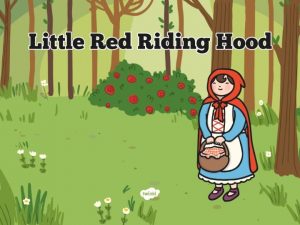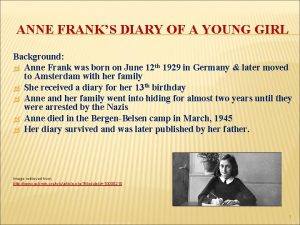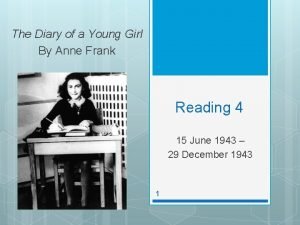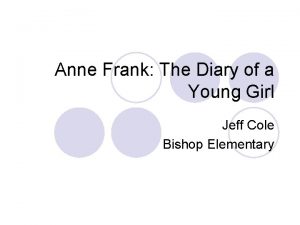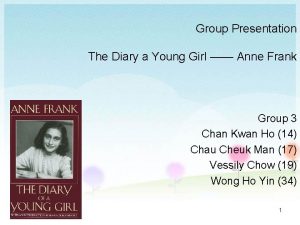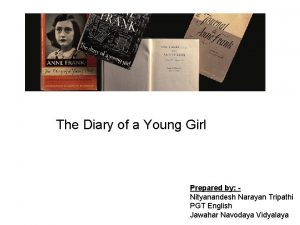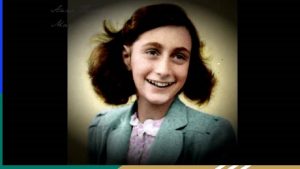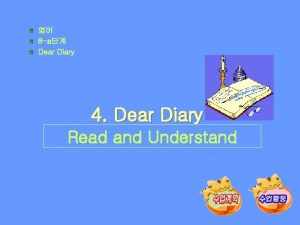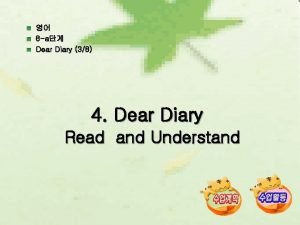The Diary of a Young Girl is an















- Slides: 15


The Diary of a Young Girl is an autobiography book of Anne Frank. This book was originally written in Dutch language and the original title of this book is “Het Achterhuis” This book was originally published on June 25, 1947.

* On Anne’s thirteenth birthday, Anne Frank’s parents gave her a diary. She was excited because she wanted someone, or something, in which to confide all of her secret thoughts. Even though she had a rich social life, she felt misunderstood by everyone she knew. Anne started writing about daily events, her thoughts, school grades, boys, all that. But, within a month, her entire life changed. As the economic crisis, Hitler’s rose to power and grow antisemitism put an end to the family’s carefree life. Anne and her family hid in the Secret Annex at Prinsengracht 263, Amsterdam, The Netherlands with another family consisting of three people and a dentist. Unfortunately, after 2 years of hiding, someone reported their hiding place to the Nazis, and everyone was captured and sent to concentration camps. Anne, along with her mother and sister, did not survive, except Anne's father, Otto Frank, he survived. After the war, he spent the rest of his life publishing and talking about his daughter's work.

* 1. Theme • The Loneliness of Adolescence Anne Frank’s perpetual feeling of being lonely and misunderstood provides the impetus for her dedicated diary writing and colours many of the experiences she recounts. • Personal Theme Personal theme is a story of someone on life or a family and tells us about suffering, sorrow, struggle, and survive. The Diary of a Young Girl tells us about Anne personal life and how Anne and her family hiding to struggle and survive even though in the end they were discovered and arrested.

2. Characteristic • Anne Frank Anne grows from an innocent, tempestuous, precocious, and somewhat petty teenage girl to mature and sensitive thinker at age fifteen. Ø June 20, 1942 Ø January 4, 1944 Ø May 3, 1944 Ø September 1, 1944 • Otto Frank Anne sees her father, Otto Frank, as a kindred spirit. Like Anne, Otto is a perpetual student, inhaling books, history, and news, and he encourages these interests in Anne. Also like Anne, he is a clown, frequently trying to amuse those around him and lighten up the mood of the Annex. But unlike young Anne, Otto seems to be basically eventempered and eager for peace in every situation. In the claustrophobic and tense living situation, Otto often serves as the peacekeeper between the Franks, van Daans, and Dussel. As much as Anne adores her father, she occasionally voices her concern that her father doesn't recognize her for the mature young woman she feels herself to be. Ø June 20, 1942 Ø October 30, 1943

• Margot Frank Anne thinks that Margot is smart, more grown-up. Ø Smart: July 5, 1942 Ø More grown-up: April 17, 1944 • Edith Frank Anne thinks her mother is too sentimental, mean mother and critical. Ø Mean: March 10, 1942 Ø Sentimental: July 12, 1942 paragraph 2, 3, 4 • Mr. Van Daan According to Anne, he is intelligent, opinionated, stern, and somewhat egotistical. Ø Stern: September 2, 1942 • Mrs. Van Daan Anne initially describes Mrs. van Daan as a friendly, teasing woman, but later calls her an instigator. She is a fatalist and can be petty, egotistical, flirtatious, stingy, and grouchy. Ø Flirtatious/teasing woman: paragraph 4. Thursday, October 1, 1942 Ø Grouchy: paragraph 3. Monday, September 21, 1942

• Peter van Daan Anne first sees Peter as obnoxious, lazy, and hypersensitive, but later they become close friends. Peter is quiet, timid, honest, and sweet. Ø Obnoxious, Lazy: Friday, August 21, 1942 paragraph 5 Ø Sweet: March 22, 1944 • Albert Dussel Alfred Dussel is a fussy old dentist and, unfortunately, Anne’s roommate in the Secret Annex. He doesn’t respect Anne at all; he demands Anne’s compliance with all of his absurd wishes while never considering hers. He is generally very selfish, never thanking the Franks or van Daans for sharing their hiding spot with him or showing any gratefulness to their protectors: Ø November 17, 1943 • Mr. Kugler A man who helps hide the Franks in the annex. Victor Kugler is arrested along with Kleiman in 1944 but escapes in 1945. He immigrates to Canada in 1955 and dies in Toronto in 1981. Mr. Kugler is also referred to as Mr. Kraler. • Mr. Kleiman Another man who helps the Franks hide. Johannes Kleiman is arrested in 1944 but released because of poor health. He remains in Amsterdam until his death in 1959. Mr. Kleiman is also referred to as Mr. Koophuis.

• Bep Voskuijl A worker in Otto Frank’s office. Elizabeth (Bep) Voskuijl helps the family by serving as a liaison to the outside world. She remains in Amsterdam until her death in 1983. • Miep Gies A secretary at Otto’s office who helps the Franks hide. After the Franks are arrested, she stows the diary away in a desk drawer and keeps it there, unread, until Otto’s return in 1945. She died in 2010 at the age of 100. • Peter Schiff The love of Anne’s life from the sixth grade. Peter Schiff is a boy one year older than Anne. She has dreams about him while in the annex. Peter Schiff is also referred to as Peter Wessel. • Helmuth “Hello” Silberberg A boy with whom Anne has an innocent, though romantic relationship before she goes into hiding. Hello is also referred to as Harry Goldberg. Ø Wednesday, July 1, 1942.

3. Setting • Time Ø June 12, 1942 – August 1, 1944 Ø World War II • Place Ø 263 Prinsengracht, The Secret Annex (Amsterdam, The Netherlands) 263 Prinsengracht is the address where the Secret Annex located. The secret annex is a hidden portion of the office building where Otto Frank’s business is housed. The four members of the Frank family, three van Daans and Albert Dussel live in this small space for nearly two and a half years in an attempt to hide from the German army. 4. Point of View • First Person Narrator Because it’s Anne’s diary. So the story is told through Anne Frank’s vision, and voice. She wrote about everything in her life, her daily events, her thoughts, school grades, boys, etc.

5. Plot • Life in Germany Anne Frank was born on 12 June 1929 in the German city of Frankfurt am Main, where her father’s family had lived for generations. She has a sister, Margot, who is three and a half years older. The economic crisis, Hitler’s rise to power and growing antisemitism put an end to the family’s carefree life. Like many other jews, Otto Frank and his wife, Edith, decide to leave Germany. • A new life in The Netherlands Otto sets up a business in Amsterdam and the family finds a home on the Merwedeplein. The children go to school, Otto works hard at his business and Edith looks after the home. When the threat of war in Europe increases, Otto and his family try to emigrate to England or the USA but these attempts fail. On 1 September 1939 Germany invades Poland. It is the beginning of the Second World War. • War in The Netherlands For a while there is hope that The Netherlands will not become involved in the war, but on 10 May 1940 German troops invade the country. Five days later The Netherlands surrenders and is occupied. Anti-Jewish regulations soon follow. Jews are allowed into fewer and fewer places. Anne and Margot must attend a Jewish school and Otto loses his business. When a renewed attempt to emigrate to the U. S. A. fails, Otto and Edith decide to go into hiding. Otto sets up a hiding place in the rear annexe of his firm at Prinsengracht 263. He does this together with his Jewish business partner, Hermman van Pels and with help from his associates Johannes Kleiman, and Victor Kugler.

• In Hiding On 5 July 1942 Margot Frank receives a call-up to report for a German work camp. The next day the Frank family goes into hiding. The Van Pels family follows a week later and in November 1942 they are joined by an eighth person: the dentist Fritz Pfeffer. They remain in the secret annexe for more than two years. In hiding, they have to keep very quiet, are often frightened and pass the time together as well as they can. They are helped by the office workers, Johannes Kleiman, Victor Kugler, Miep Gies and Bep Voskuijl; by Miep’s husband, Jan Gies; and by the warehouse manager, Johannes Voskuijl, Bep’s father. These helpers not only arrange food, clothes and books, they are the group’s contact with the outside world. • A Diary as A Best Friend Shortly before going into hiding Anne receives a diary for her birthday. She starts writing straightaway and during her time in hiding she writes about events in the secret annex and about herself. Her diary is a great support to her. Anne also writes short stories and collects quotations from other writers in her ‘book of beautiful sentences’. When the Dutch minister of education in exile in London appeals on British radio for people to keep war diaries, Anne decides to edit her diary and create a novel called 'The Secret Annex'. She starts to rewrite, but she and the others are discovered and arrested before she has finished. • Arrest and Deportation On 4 August 1944 the people in hiding are arrested, along with their helpers Johannes Kleiman and Victor Kugler. They pass from the security service headquarters and prison to the transit camp Westerbork, from where they are deported to Auschwitz. The two helpers are sent to the Amersfoort camp. Johannes Kleiman is released

shortly after his arrest and six months later Victor Kugler escapes. Immediately after the arrests Miep Gies and Bep Voskuijl rescue Anne's diary and papers that have been left behind in the secret annex. Despite intensive investigations it has never been clear how the hiding place was discovered. • Otto Frank Returns Otto Frank is the only one of the eight people in hiding to survive the war. During his long journey back to The Netherlands he learns that his wife, Edith, has died. He knows nothing about his daughters and still hopes to see them again. He arrives back in Amsterdam at the beginning of July. He goes straight to Miep and Jan Gies and remains with them for another seven years. Otto Frank tries to find his daughters, but in July he receives the news that they both died of disease and deprivation in Bergen. Belsen. Miep Gies then gives him Anne’s diary papers. Otto reads the diary and discovers a completely different Anne. He is very moved by her writing. • Anne’s Diary Anne wrote in her diary that she wants to become a writer or a journalist in the future, and that she wants to publish her diary as a novel. Friends convince Otto Frank that the diary has great expressive power and on 25 June 1947 The Secret Annexe is published in an edition of 3, 000. Many more editions follow, also translations, a play and a film. People from all over the world learn of Anne Frank's story. Over the years Otto Frank answers thousands of letters from people who have read his daughter's diary. In 1960 the Anne Frank House becomes a museum. Otto Frank remains

6. Tone • Youthful; Optimistic with Jolts of Anger, Irony, and Humor the tone of the diary of a thirteen-to-fifteen-year-old girl is youthful. To be fair, Anne does have many surprisingly mature insights into life, war, interpersonal relationships, and much more. But this is always set against the generally youthful tone of her writing. . . and this makes the diary that much more poignant. She has concerns like boys, arguments with her parents, and friends. She frequently talks about wanting to be grown up already and she often gets all giddy about the boy she likes: “In the meantime, things are getting more and more wonderful here. I think, Kitty, that true love may be developing in the Annex. All those jokes about marrying Peter if we stayed here long enough weren’t so silly after all. Not that I’m thinking of marrying him, mind you. I don’t even know what he’ll be like when he grows up. Or if we’ll even love each other enough to get married” (Wednesday, March 22, 1944) Anne’s writing also tends to be optimistic. She seems to be like her dad in that way. She is generally optimistic about life within the Secret Annex, and thankful for her family’s protection. But at times Anne can complain or grow angry about conditions or how others treat her, or be righteously angry at fellow Annex members for being selfish: “I should explain that yesterday was November 16, the first anniversary of his [Mr. Dussel’s] living in the Annex [. . . ] instead of taking the opportunity to thank us – for the first time – Qfor unselfishly taking him in, he didn’t utter a word” (Wednesday November 17, 1943)

* 1. Value a) Moral Values: • Always be grateful “When I think about our lives here, I usually come to the conclusion that we live in a paradise compared to the Jews who aren’t in hiding” (Tuesday, September 29, 1942) • Have the courage to be yourself “I know what I want, I have a goal, an opinion, I have a religion and love. Let me be myself and then I am satisfied. I know that I’m a woman, a woman with inward strength and plenty of courage” • Never give up on yourself and your dreams “It’s difficult in times like these: ideals, dreams and cherished hopes rise within us, only to be crushed by grim reality. It’s a wonder I haven’t abandoned all my ideals, they seem so absurd and impractical, yet I cling to them because I still believe, in spite of everything that people are truly good at heart” 2. Important Messages • All people have the right to live in freedom • Just because people may be a different religion or race, that doesn’t mean they should be treated differently

THANK YOU
 Red riding hood
Red riding hood Stone girl bone girl
Stone girl bone girl Girl and boy xxxx
Girl and boy xxxx What is the shape of dr. jekyll’s house
What is the shape of dr. jekyll’s house Thế nào là hệ số cao nhất
Thế nào là hệ số cao nhất Diễn thế sinh thái là
Diễn thế sinh thái là Vẽ hình chiếu vuông góc của vật thể sau
Vẽ hình chiếu vuông góc của vật thể sau Frameset trong html5
Frameset trong html5 Làm thế nào để 102-1=99
Làm thế nào để 102-1=99 Lời thề hippocrates
Lời thề hippocrates Chụp phim tư thế worms-breton
Chụp phim tư thế worms-breton đại từ thay thế
đại từ thay thế Vẽ hình chiếu đứng bằng cạnh của vật thể
Vẽ hình chiếu đứng bằng cạnh của vật thể Quá trình desamine hóa có thể tạo ra
Quá trình desamine hóa có thể tạo ra Thế nào là mạng điện lắp đặt kiểu nổi
Thế nào là mạng điện lắp đặt kiểu nổi Khi nào hổ con có thể sống độc lập
Khi nào hổ con có thể sống độc lập
